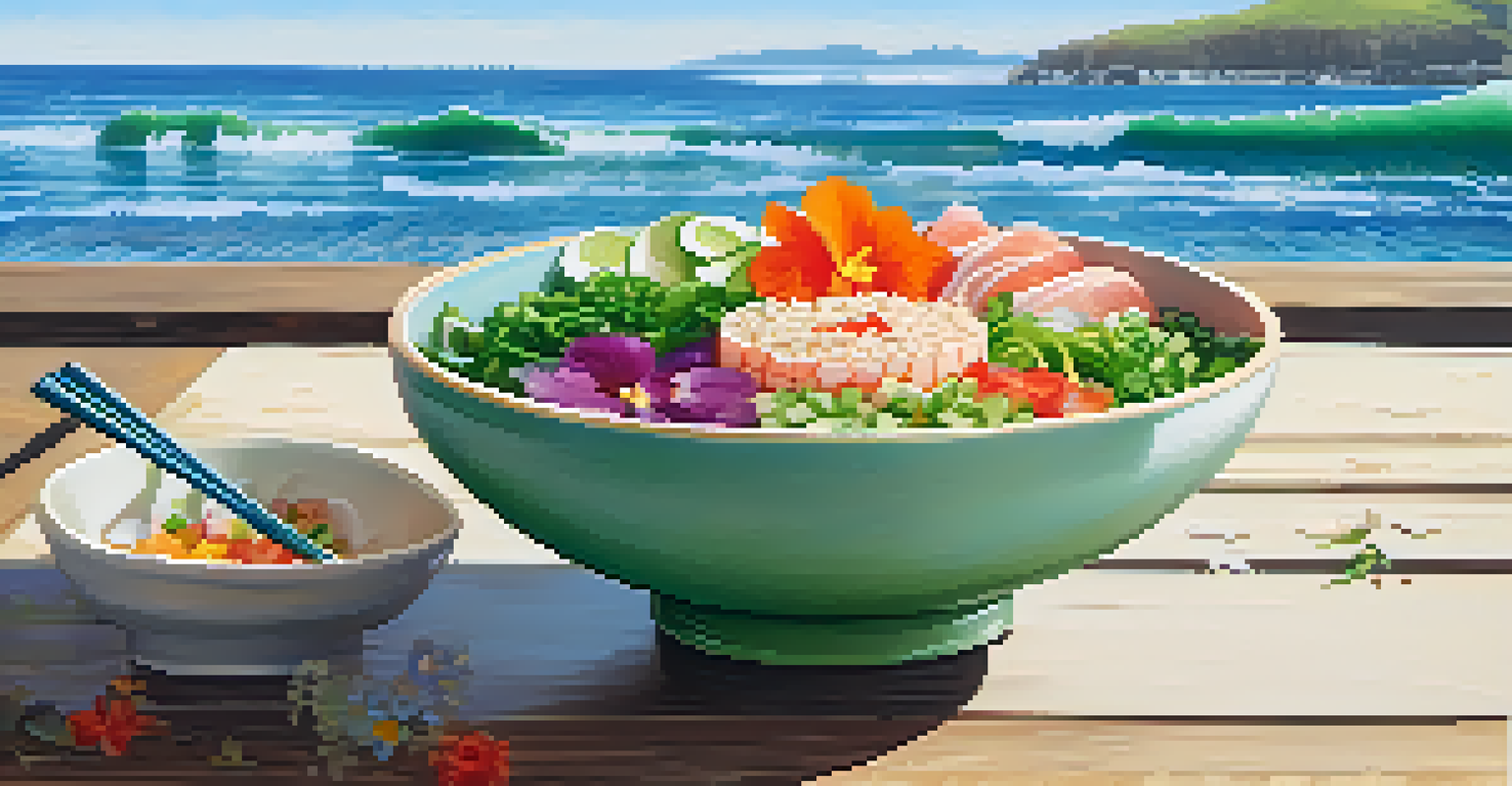A Culinary Journey: Traditional Hawaiian Cooking Techniques Explained

The Heart of Hawaiian Cuisine: A Cultural Overview
Hawaiian cuisine is a vibrant tapestry woven from diverse cultural influences, reflecting the islands' rich history. From ancient Polynesian traditions to the flavorful impacts of Chinese, Japanese, and Portuguese settlers, each culture has contributed unique ingredients and cooking methods. The result is a culinary landscape that celebrates both the land and sea, making use of locally sourced produce and fresh seafood.
Food is a central part of Hawaiian culture and tradition, representing the spirit of aloha and the importance of community.
At its core, Hawaiian cooking is about community and sharing, often centered around family gatherings and celebrations. Traditional feasts, known as luau, showcase an array of dishes that highlight the importance of food in uniting people and honoring traditions. This emphasis on communal dining is a key aspect that makes Hawaiian cuisine so special.
Understanding this cultural backdrop enhances the appreciation of Hawaiian cooking techniques, each with its own story and significance. As we explore the various methods, we’ll see how they connect to the islands' history and the people who have shaped its culinary identity.
Imu: The Underground Oven Technique
One of the most iconic cooking methods in Hawaiian cuisine is the imu, a traditional underground oven. This technique involves digging a pit in the earth, lining it with rocks, and then filling it with hot stones heated by a fire. Food, often wrapped in banana leaves, is placed on top of the stones and covered with earth, creating a slow-cooking environment that infuses the ingredients with a unique smoky flavor.

The imu is not just about cooking; it’s also a communal event. Friends and family gather to participate in the preparation, making it a bonding experience. The unveiling of the imu is a moment of excitement, as everyone eagerly awaits the deliciously tender meats and vegetables that have been cooking for hours.
Hawaiian Cuisine: A Cultural Blend
Hawaiian cuisine is a rich tapestry of diverse cultural influences, showcasing the significance of community and shared meals.
This ancient technique exemplifies the Hawaiian spirit of sharing and togetherness, highlighting the significance of food in cultural rituals. The imu continues to be a popular choice for special occasions, reminding us of the deep-rooted traditions that remain alive today.
Poke: A Fresh and Flavorful Seafood Delight
Poke, pronounced 'poh-keh', is a beloved dish that showcases the bounty of Hawaii's ocean. This simple yet flavorful preparation involves cubed raw fish, often seasoned with ingredients like soy sauce, sesame oil, and green onions. The beauty of poke lies in its versatility, allowing for various adaptations based on personal preferences and local ingredients.
Cooking is like love. It should be entered into with abandon or not at all.
Traditionally made with ahi (tuna), poke has evolved to include a variety of seafood and toppings, making it a favorite among locals and visitors alike. It's commonly served as an appetizer or a light meal, reflecting the fresh, vibrant flavors that define Hawaiian cuisine. The dish is often enjoyed in a casual setting, emphasizing the laid-back lifestyle of the islands.
Poke is not just a meal; it’s a celebration of the ocean and its resources. By using sustainable practices and locally sourced fish, this dish embodies the Hawaiian respect for nature and the importance of maintaining a connection to the land and sea.
Lomi Lomi Salmon: A Unique Salad Experience
Lomi lomi salmon is a refreshing salad that combines fresh salmon, tomatoes, onions, and a sprinkle of salt. The name 'lomi lomi' means 'to massage' in Hawaiian, which speaks to the traditional method of preparing the dish. The ingredients are gently massaged together, allowing the flavors to meld and creating a delightful, textured dish that’s perfect for warm weather.
This dish has its roots in the native Hawaiian culture, where it was often served at celebrations and gatherings. The bright colors and fresh ingredients make lomi lomi salmon not only delicious but also visually appealing. It’s a reminder of how food can be a feast for the eyes as well as the palate.
Traditional Techniques Enhance Flavor
Cooking methods like the imu and dishes such as poke highlight the importance of traditional practices that infuse unique flavors into Hawaiian food.
Lomi lomi salmon exemplifies the Hawaiian philosophy of using fresh, local ingredients to create dishes that are both simple and satisfying. It serves as a perfect accompaniment to a luau or any gathering, bringing a taste of the islands to the table.
Kalua Pig: The Flavorful Star of Hawaiian Feasts
Kalua pig is a staple at Hawaiian luaus, celebrated for its rich flavor and tender texture. This dish is prepared by cooking a whole pig in an imu, allowing it to slow-roast for hours until the meat is fall-off-the-bone tender. The process infuses the pork with a smoky flavor that is simply irresistible, making it the star of any feast.
The tradition of kalua pig dates back to ancient Hawaii, where it was reserved for special occasions and gatherings. Today, it continues to be a symbol of hospitality and celebration, often served alongside rice and various side dishes. The communal aspect of preparing and enjoying kalua pig fosters a sense of togetherness and joy.
Kalua pig showcases the heart of Hawaiian cooking—simple, yet deeply flavorful. It’s a dish that brings people together, reminding us of the importance of sharing meals and creating lasting memories.
Saimin: A Noodle Soup with a Local Twist
Saimin, a comforting noodle soup, is a dish that reflects the multicultural influences of Hawaii. It draws inspiration from Japanese ramen, Chinese mein, and Filipino pancit, resulting in a unique blend of flavors and textures. Typically served with a savory broth, saimin is often topped with green onions, fish cake, and sometimes even a slice of Spam!
This dish is not just a meal; it’s a beloved comfort food for many locals. Often enjoyed at casual eateries and food trucks, saimin embodies the spirit of Hawaii’s diverse culinary landscape. Each bowl tells a story of cultural exchange and adaptation, making it a favorite among residents and visitors alike.
Celebrating with Sweet Desserts
Desserts like haupia and malasadas not only offer delightful flavors but also symbolize the joy of gathering and celebrating with loved ones.
Saimin’s ability to incorporate various ingredients reflects the resourcefulness of Hawaiian cooks, who creatively adapt dishes to suit local tastes. It's a delicious reminder of how food can evolve while still honoring its roots.
The Sweet Side: Haupia and Other Desserts
No exploration of Hawaiian cuisine would be complete without mentioning its delightful desserts, with haupia leading the way. Haupia is a traditional coconut milk-based dessert that is often served at luaus and celebrations. Its creamy texture and subtle sweetness make it a refreshing treat, perfect for cooling off in Hawaii’s warm climate.
Alongside haupia, you’ll find other popular desserts like malasadas (Portuguese doughnuts) and pineapple upside-down cake, each with its own history and cultural significance. These treats often incorporate local ingredients, showcasing the natural sweetness of tropical fruits and the influence of various cultures within Hawaii.

Desserts in Hawaiian cuisine are more than just a sweet ending; they symbolize the joy of gathering and celebrating with loved ones. Enjoying these treats is a reminder of the island’s spirit of aloha and the importance of sharing happiness through food.
Bringing Hawaiian Cooking Techniques Home
Now that we've explored the rich tapestry of traditional Hawaiian cooking techniques, you might be wondering how to bring some of these flavors into your own kitchen. Start by experimenting with fresh ingredients like fish, tropical fruits, and locally sourced vegetables to create your own versions of dishes like poke and lomi lomi salmon. Embrace the spirit of sharing by hosting a luau-inspired gathering with friends and family.
Consider trying your hand at the imu technique in a backyard setting by using a makeshift pit or a smoker to capture that smoky flavor in meats. While it may not be an exact replica of the traditional method, it allows you to connect with the essence of Hawaiian cooking and create a memorable meal.
As you dive into these techniques, remember that the heart of Hawaiian cuisine is about community, culture, and sharing experiences. Enjoy the journey of exploring these flavors and techniques, and let the aloha spirit guide your culinary adventures.